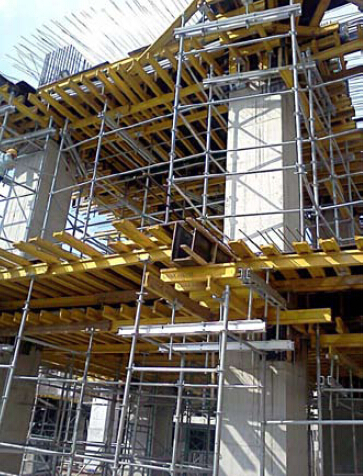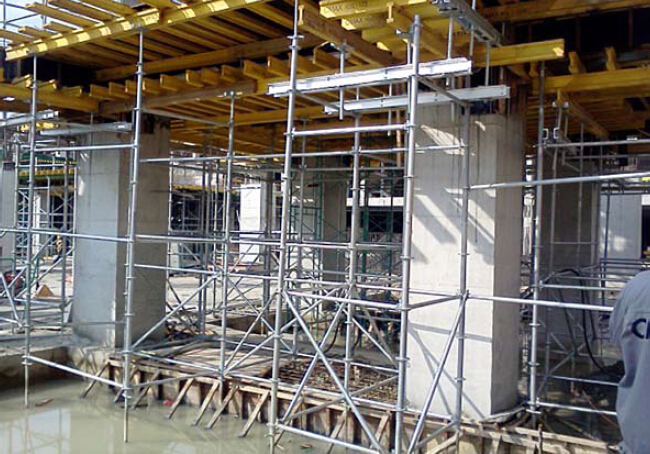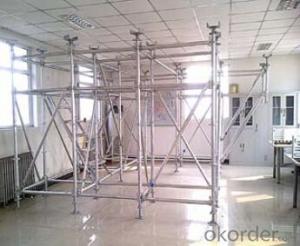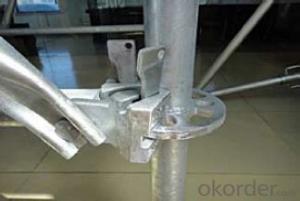Ring-lock Scaffolding Accessories for Formwork and scaffolding System
- Loading Port:
- Tianjin
- Payment Terms:
- TT OR LC
- Min Order Qty:
- 50 m²
- Supply Capability:
- 1000 m²/month
OKorder Service Pledge
Quality Product, Order Online Tracking, Timely Delivery
OKorder Financial Service
Credit Rating, Credit Services, Credit Purchasing
You Might Also Like
Ring-lock Scaffolding
A support system for construction, ownsadvantages of both cup-lock scaffolding andshoring tower.
It is in the development direction of new typescaffolding.
It is widely used in buildings, bridges, tunnels etc..
Characteristics:
◆ Easy to storage and transportation
◆ High degree of standardization
◆ Easy and quick erection
◆ Excellent stability and bearing capacity


- Q:What are the considerations when designing steel formwork for dams?
- When designing steel formwork for dams, several key considerations need to be taken into account. Firstly, the structural stability and strength of the formwork is of utmost importance. Dams are large structures that exert significant forces, so the formwork needs to be able to withstand these forces without any deformation or failure. This requires careful analysis and design of the formwork system, including the selection of appropriate steel grades, sizes, and reinforcement. Another important consideration is the water pressure that the formwork will be subjected to during the construction and operation of the dam. The formwork needs to be watertight to prevent any leakage or seepage, as this can compromise the stability and integrity of the dam. Special attention should be given to the joints and connections of the formwork to ensure a tight and secure seal. Durability is another factor that needs to be considered when designing steel formwork for dams. Dams have a long design life, often spanning several decades, so the formwork needs to be able to withstand prolonged exposure to various environmental conditions, such as temperature changes, moisture, and chemical exposure. The formwork should be protected against corrosion, either through the use of corrosion-resistant steel or by applying protective coatings. The ease of assembly and disassembly is also an important consideration. Dams are complex structures that require a large number of formwork elements to be assembled and aligned accurately. The formwork system should be designed in a way that allows for easy and efficient installation and removal, minimizing the time and effort required for construction. Lastly, cost considerations play a significant role in the design of steel formwork for dams. The formwork system needs to be cost-effective and efficient, maximizing the use of materials and minimizing waste. The design should also take into account the availability and cost of steel, as well as the availability of skilled labor for fabrication and installation. Overall, the considerations when designing steel formwork for dams include structural stability, watertightness, durability, ease of assembly, and cost-effectiveness. By carefully addressing these factors, engineers can ensure the successful construction and long-term performance of the dam.
- Q:What are the different safety certifications and standards for steel formwork?
- Steel formwork is subject to various safety certifications and standards to guarantee its safe use in construction projects. These certifications and standards ensure that the steel formwork meets specific safety requirements. Some of the safety certifications and standards for steel formwork include the following: 1. ISO 9001: This certification confirms that the steel formwork manufacturer has implemented a quality management system and meets the necessary quality standards. It focuses on the overall quality and reliability of the product. 2. ISO 3834: This certification guarantees that the welding processes used in the production of steel formwork adhere to specific quality requirements. It emphasizes the welding quality and ensures strong and durable welds. 3. EN 12812: This European standard provides guidelines for the design and performance of formwork systems, including steel formwork. It covers aspects such as load-bearing capacity, stability, and safety requirements for formwork systems. 4. OSHA: The Occupational Safety and Health Administration establishes safety standards for the construction industry in the United States. While there are no specific certifications for steel formwork, compliance with OSHA standards is crucial to ensure a safe working environment for construction workers who use steel formwork. 5. BS 5975: This British standard offers recommendations for temporary works, including formwork systems. It covers design, erection, use, and dismantling of formwork systems, ensuring safety throughout the construction process. 6. ACI 347: This American Concrete Institute standard provides guidelines for the design, construction, and maintenance of concrete structures. It includes recommendations for formwork systems, including steel formwork, to ensure their safety and effectiveness in supporting the concrete during construction. These safety certifications and standards are essential to manufacture and use steel formwork safely in construction projects. By adhering to these certifications and standards, construction companies can guarantee the safety of their workers and the quality of their structures. It is crucial for construction professionals to be aware of these certifications and standards and ensure compliance with them when utilizing steel formwork.
- Q:Can steel formwork be used in coastal or marine construction projects?
- Yes, steel formwork can be used in coastal or marine construction projects. Steel is a durable and corrosion-resistant material that can withstand the harsh conditions of coastal environments. It provides a strong and stable framework for concrete structures, making it suitable for various applications such as retaining walls, piers, and jetties. Additionally, steel formwork is reusable, making it a cost-effective choice for these types of projects.
- Q:Can steel formwork be used in cultural or entertainment facility construction projects?
- Yes, steel formwork can be used in cultural or entertainment facility construction projects. Steel formwork offers several advantages such as durability, strength, and versatility, making it suitable for various construction projects including those in the cultural and entertainment sectors. It provides efficient and cost-effective solutions for creating complex structures and intricate designs required in these types of facilities.
- Q:How does steel formwork contribute to the overall cost of concrete construction?
- Steel formwork contributes to the overall cost of concrete construction in several ways. Firstly, the initial investment in steel formwork can be higher compared to other types of formwork materials such as timber or plastic. However, steel formwork offers long-term durability and reusability, which can offset the higher upfront cost over the lifespan of multiple construction projects. Additionally, the use of steel formwork can significantly reduce the time required for formwork assembly and dismantling. This leads to increased efficiency and productivity on the construction site, resulting in potential cost savings in terms of labor and project duration. Moreover, steel formwork is known for its superior strength and stability, which allows for the construction of larger and more complex structures. This can eliminate the need for additional support structures or reinforcements, ultimately reducing construction costs. Furthermore, steel formwork provides a smooth and high-quality finish to the concrete structure, eliminating the need for additional plastering or finishing work. This not only saves material costs but also reduces the overall construction time. Lastly, the reusability of steel formwork enables multiple applications on different projects, providing a long-term cost benefit. Unlike other formwork materials that may require frequent replacement, steel formwork can be used for multiple construction cycles, reducing the need for new formwork materials and saving costs in the long run. Overall, while the initial investment in steel formwork may be higher, its durability, efficiency, superior strength, and reusability contribute to cost savings in terms of labor, project duration, material usage, and long-term formwork expenses.
- Q:How does steel formwork prevent concrete segregation?
- The use of steel formwork is essential in preventing concrete segregation. This is because steel formwork offers a sturdy and unyielding structure for the concrete to be poured into. Unlike wood or plastic formwork materials, steel formwork remains intact and free from any movement or distortion throughout the pouring and curing process. Concrete segregation arises when the different constituents of concrete, namely cement, aggregates, and water, separate from one another. This leads to an uneven distribution of these constituents within the mixture. Consequently, the concrete structure becomes weakened, causing problems such as reduced strength, cracking, or the formation of voids. Steel formwork effectively combats concrete segregation by providing a smooth and uniform surface for the concrete to be poured onto. The inflexible nature of steel ensures that there are no gaps or spaces for the concrete constituents to separate or settle unevenly. This guarantees a consistent and even distribution of cement, aggregates, and water throughout the entire concrete mixture. Furthermore, steel formwork creates a tight seal against the sides and bottom of the form, preventing any leakage or loss of moisture during the curing process. This is crucial in maintaining the desired water-cement ratio, which is vital for the proper hydration and solidification of the concrete. By averting excessive evaporation or moisture loss, steel formwork ensures that the concrete cures uniformly, minimizing the risk of segregation. Moreover, the use of steel formwork allows for precise and accurate placement of the concrete, eliminating any potential gaps or voids that could contribute to segregation. The design of steel formwork can incorporate various features such as tie rods, clamps, or connectors to securely hold the formwork panels in place. This guarantees that the concrete is poured and compacted uniformly, ensuring a homogeneous mixture. To summarize, steel formwork serves as a reliable solution to prevent concrete segregation. It offers a stable and inflexible structure that upholds the shape and integrity of the concrete mixture. By preventing the separation of constituents, ensuring a consistent distribution of materials, and enabling accurate placement of the concrete, steel formwork results in a stronger and more durable structure.
- Q:Can steel formwork be used in seismic-prone areas?
- Indeed, steel formwork is applicable in regions prone to seismic activity. The commendable strength and durability of steel formwork renders it appropriate for deployment in areas with intense seismic occurrences. This material exhibits remarkable resistance against the horizontal forces generated during an earthquake, thereby guaranteeing the integrity of the formwork system. Moreover, steel formwork presents design versatility, allowing for convenient alterations or adjustments to cater to the specific demands of seismic-prone regions. Nonetheless, it is crucial to implement appropriate engineering and design considerations when utilizing steel formwork in such areas to ensure compliance with the requisite safety standards and regulations.
- Q:What are the different types of coatings available for steel formwork?
- There are several types of coatings available for steel formwork, each with its own unique advantages and applications. 1. Paint coatings: These coatings provide a basic level of protection against corrosion and can be applied in various colors. They are typically inexpensive and easy to apply, making them a popular choice for general-purpose formwork. 2. Galvanized coatings: Galvanizing involves applying a layer of zinc to the steel surface, providing excellent corrosion resistance. It is particularly suitable for formwork used in harsh environments or where long-term durability is required. 3. Epoxy coatings: Epoxy coatings offer superior chemical resistance and durability compared to other types of coatings. They are commonly used in formwork that will come into contact with aggressive substances or in applications requiring a high level of hygiene, such as in the food industry. 4. Powder coatings: Powder coatings are applied as a dry powder and then baked to form a hard, durable finish. They offer excellent impact resistance and are available in a wide range of colors. Powder coatings are often used in formwork that will be exposed to significant wear and tear. 5. Polymer coatings: Polymer coatings, such as polyurethane or polyethylene, provide a protective layer over the steel surface. They offer good resistance to abrasion, impact, and chemicals, making them suitable for formwork used in demanding applications. 6. Thermal spray coatings: Thermal spray coatings involve the application of a molten material, such as zinc or aluminum, onto the steel surface. These coatings offer exceptional corrosion resistance and are commonly used in marine or offshore formwork. When selecting the appropriate coating for steel formwork, factors such as the intended use, environmental conditions, and budget should be considered. It is important to consult with coating specialists or manufacturers to determine the most suitable coating for specific applications.
- Q:What are the common safety guidelines when working with steel formwork in confined spaces?
- When working with steel formwork in confined spaces, some common safety guidelines include ensuring proper ventilation to prevent the buildup of hazardous gases, regularly monitoring the atmosphere for toxic substances, providing adequate lighting and emergency exit routes, wearing appropriate personal protective equipment such as gloves, safety glasses, and respiratory protection, training workers on the potential hazards and safe work practices, and having a standby person outside the confined space to monitor and assist if needed.
- Q:What are the standard dimensions of steel formwork panels?
- The standard dimensions of steel formwork panels can vary, but they are typically around 2.4 meters in length and 0.6 meters in width. The thickness of these panels can range from 12mm to 20mm. However, it is important to note that these dimensions can vary depending on the specific project requirements and the formwork manufacturer.
1. Manufacturer Overview |
|
|---|---|
| Location | |
| Year Established | |
| Annual Output Value | |
| Main Markets | |
| Company Certifications | |
2. Manufacturer Certificates |
|
|---|---|
| a) Certification Name | |
| Range | |
| Reference | |
| Validity Period | |
3. Manufacturer Capability |
|
|---|---|
| a)Trade Capacity | |
| Nearest Port | |
| Export Percentage | |
| No.of Employees in Trade Department | |
| Language Spoken: | |
| b)Factory Information | |
| Factory Size: | |
| No. of Production Lines | |
| Contract Manufacturing | |
| Product Price Range | |
Send your message to us
Ring-lock Scaffolding Accessories for Formwork and scaffolding System
- Loading Port:
- Tianjin
- Payment Terms:
- TT OR LC
- Min Order Qty:
- 50 m²
- Supply Capability:
- 1000 m²/month
OKorder Service Pledge
Quality Product, Order Online Tracking, Timely Delivery
OKorder Financial Service
Credit Rating, Credit Services, Credit Purchasing
Similar products
New products
Hot products
Hot Searches
Related keywords

























